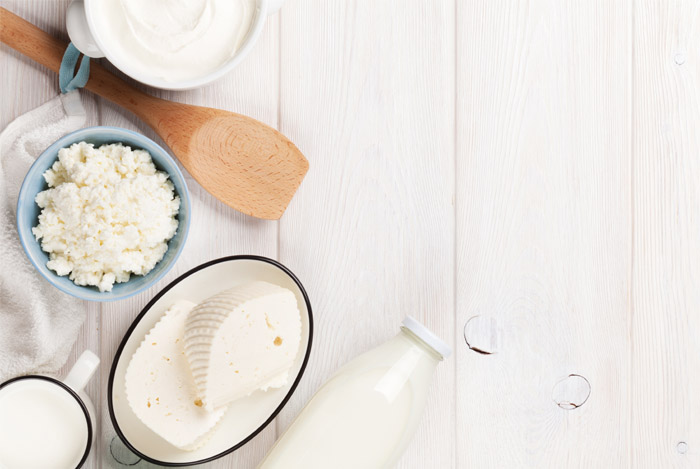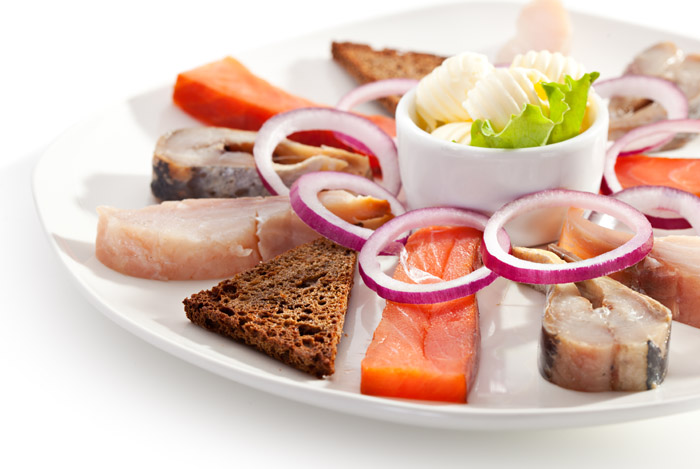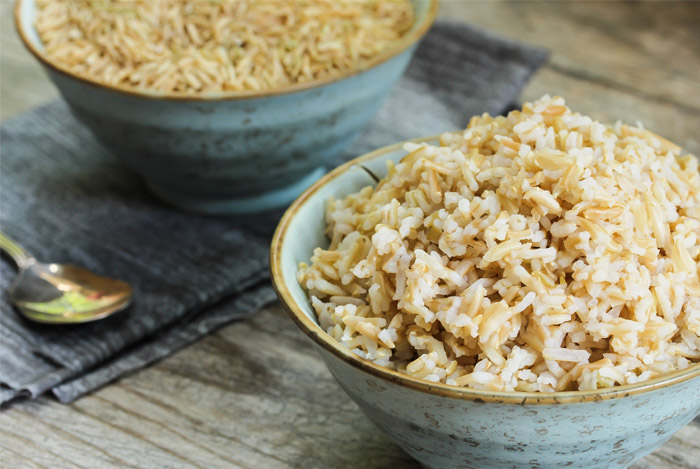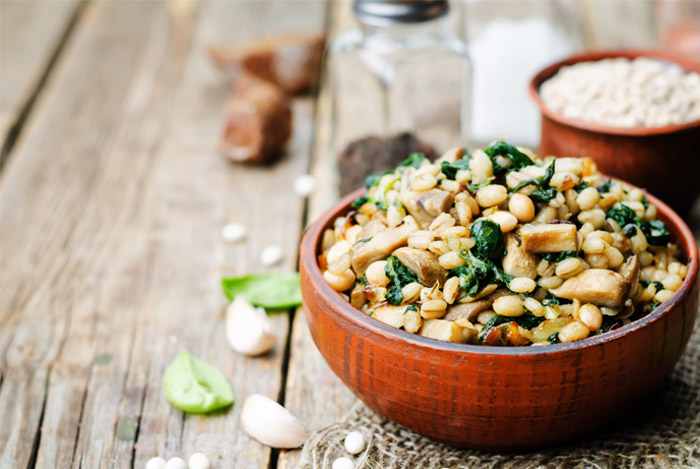Most people associate nutrient deficiencies with starving children in third world countries or people who eat nutritionally devoid fast food on a daily basis.
In our world of fortified food products, enriched junk food, and vitamin flavored sugar water, it almost seems inconceivable that people in developed countries suffer from nutrient deficiencies.
But most people don’t realize that a multivitamin or vitamins sprayed on food products are no substitute for the nutrients found in whole foods such as fruits and veggies.
These nutrient deficiencies may be harming your health, keeping you from feeling your best, and stunting your body’s ability to perform or function properly.
Nutrient deficiencies trigger issues at the most basic cellular level including:
- Water balance
- Nerve signaling
- Enzyme function
- Digestion
- Metabolism
Not getting all of your essential nutrients also puts you at risk for developing certain diseases – yikes!
We typically don’t know we’re deficient in certain nutrients until we start feeling a little under the weather. We can sense that something’s off, but we just can’t put our finger on it.
So today we’ll be talking all about the most common nutrient deficiencies and what you can do to prevent the consequences of being deficient.
Iron
 How many people do you know who care about their iron levels as much as say their vitamin C?
How many people do you know who care about their iron levels as much as say their vitamin C?
That may be why “iron deficiency is the most common nutritional deficiency in the United States.”
Ignoring this mineral is a big mistake. Iron helps the most important part of your body: your blood.
Iron is essential for the production of hemoglobin, the protein that helps red blood cells carry oxygen throughout your body.
When you’re deficient in iron, less oxygen is circulated to your tissues and your cells start dying at an alarming rate due to being deprived of the oxygen they need.
Iron’s also involved in the regulation of cell growth, cell functioning, and the synthesis of certain hormones.
Just a slight deficiency in iron causes anemia. Chronic iron deficiency may even lead to organ failure.
According to one review, patients with heart failure had a 30%–50% prevalence of iron deficiency. The researchers concluded that “iron deficiency is associated with poorer clinical outcomes and a greater risk of death.”
It’s kind of a big deal, right?
Signs of an iron deficiency include:
- Feeling extremely tired and fatigued
- Headaches
- Dull, pale skin
- Thinning hair
- Becoming short of breath easily
- Restless leg syndrome
- Anxiety
Menstruating women need more iron than men because they lose iron during their periods every month, which is why the recommended daily iron intake is 8–11 mg for men and 15–18 mg for women, depending on age.
Here are your best sources of iron:
- 1/2 cup pumpkin seeds: 17 mg (94% DV – daily value)
- One medium oyster: 2.6 mg (14% DV)
- 1 cup cooked lentils: 6.6 mg (37% DV)
- 1 cup cooked spinach: 6.4 mg (36% DV)
Calcium
 Calcium is the champion of strong bones and works to constantly build and maintain them. It’s also needed to help control the function of your muscles and nerves.
Calcium is the champion of strong bones and works to constantly build and maintain them. It’s also needed to help control the function of your muscles and nerves.
Signs of calcium deficiency include:
- Muscle cramps
- Fatigue
- Poor appetite
- Abnormal heart rhythms
That’s why we should all aim for 1,000–1,300 mg of calcium per day based on our age and gender.
You don’t have to chug a gallon of dairy milk to meet your calcium goals for the day; yogurt and cheese are also great sources.
But the best source of calcium may actually surprise you: dark leafy greens. Kale actually has more bioavailable calcium than milk.
For “every gram of kale there is 1.35 mg of calcium. For every gram of whole milk, there is 1.13 mg.”
What’s really important here is that kale doesn’t contain casein, the protein in milk that’s often hard for our bodies to digest.
One study confirms that getting calcium solely from dairy products is dangerous because “casein, calcium, lactose, saturated fat, and cholesterol” all contribute to poor health, but all of the same “nutrients found in milk are readily available in healthier foods from plant sources” like kale.
Unlike its relative spinach, kale has a very low oxalate content. When vegetables have high oxalate contents, they “bind calcium and prevent absorption from the digestive tract,” Jack Norris, R.D., says.
Even the National Osteoporosis Foundation endorses superfood kale because calcium strengthens our bones and prevents bone loss, preventing osteoporosis.
Just make sure you’re balancing your calcium intake with other vitamins such as vitamin D, K2, and magnesium. Unbalanced levels may lead to increased risks of serious medical issues such as heart attacks and strokes.
Vitamin D
 Although not often glamorized, vitamin D — aka the sunshine vitamin — is involved in over 45 health conditions and functions.
Although not often glamorized, vitamin D — aka the sunshine vitamin — is involved in over 45 health conditions and functions.
Vitamin D is critical for skeletal and dental health because it regulates the amount of phosphate and calcium in your body, which you need so your bones develop and repair themselves.
Without this killer calcium/vitamin D combo, bones aren’t as strong as they should be and may become fragile, brittle, and break easily, even without a serious injury!
Vitamin D also has the ability to help prevent brain disorders like dementia and Alzheimer’s.
However, vitamin D deficiency has become more common because we’re all getting smarter.
You see, we used to get most of our vitamin D from the sun. The sun’s ultraviolet rays hit our skin and cause vitamin D synthesis to occur.
But now that we’re all wearing sunblock during our outdoor activities (right?!), we’re blocking most of the vitamin D from getting into our skin.
Even sunscreens with an SPF of 8 lessen a person’s ability to produce vitamin D by 95%!
Plus, now that technology has become such a big part of our lives, we’re spending more time indoors instead of out in the sun.
We need to be careful about this.
According to one study, when scientists followed almost 50,000 men for 10 years, they found that men who had a vitamin D deficiency were twice as likely as men who had normal vitamin D levels to have a heart attack.
Vitamin D deficiencies can be hard to pinpoint, but may include:
- Fatigue
- Muscle weakness
- Muscle aches
- Achy bones
- Bone softening (prolonged deficiency)
So how much vitamin D should you aim for?
Adults under 70 need 600 IU daily. Those over 70 require 800 IU per day because it’s harder for skin to convert sunlight to vitamin D at this age. Plus, the kidneys in those over the age of 70 start to lose their ability to convert vitamin D to an active form.
Milk, eggs, cheese, and yogurt will offer up some quality vitamin D, as will fatty fish. If you nosh on tuna or salmon, surprisingly healthy fatty foods, just twice a week you’ll meet your requirements.
Vitamin B12
 Vitamin B12 is often touted as the “energy vitamin” because “your internal energy factories just don’t work as well without it,” Kathi Kemper, MD, director of the Center for Integrative Health and Wellness at Ohio State University, says.
Vitamin B12 is often touted as the “energy vitamin” because “your internal energy factories just don’t work as well without it,” Kathi Kemper, MD, director of the Center for Integrative Health and Wellness at Ohio State University, says.
Of course, all of the B vitamins help your body convert food into glucose, which gives you energy.
But vitamin B12 is quite a busy bee and also helps our bodies with:
- Production elements of DNA
- Creating red blood cells
- Making neurotransmitters in our brains
- Regenerating bone marrow and the lining of the GI and respiratory tracts
- Maintaining the health of the nervous system and spinal cord
Here’s the bad news though: you can only get B12 from animal sources, which is why B12 deficiencies have been on the rise thanks to the popularity of vegan and vegetarian lifestyles.
This is definitely a double-edged sword. Although vegans and vegetarians enjoy better heart health, according to one review, “vitamin B12 deficiency may negate the cardiovascular disease prevention benefits of vegetarian diets.”
So that’s why all men and women need to get 2.4 mcg daily.
If you don’t, B12 deficiency may lead to:
- Numbness in your extremities
- Anemia
- Memory loss
- Fatigue
- Problems walking and balancing
- Low blood pressure
- Paranoia and hallucinations
Those are definitely not issues you want to mess with. That’s why it’s imperative to get your very small required amount of B12 by eating foods such as cooked shellfish, fatty fish such as salmon and mackerel, grass-fed beef, and eggs.
Magnesium
 According to Dr. Mercola, magnesium is the fourth most abundant mineral in our body, “yet an estimated 80% of Americans are deficient in it.”
According to Dr. Mercola, magnesium is the fourth most abundant mineral in our body, “yet an estimated 80% of Americans are deficient in it.”
It’s hard to believe that anyone can even function without magnesium when you think about how important it is for your body. It plays a role in detoxifying, cardiovascular health, supporting healthy bones, and even aids in energy production.
Magnesium’s also crucial for aiding in digestion and the conversion of vitamin D so our bodies can absorb it as calcium, knocking out another vitamin deficiency.
An adequate intake of magnesium means you’ll get help absorbing energy from food, promote healthy thyroid functioning, and repair tissues.
As if that’s not enough for this one mineral to accomplish, magnesium’s also referred to as the “original chill pill” because it helps ease stress and ward off anxiety so you can fall asleep faster and stay asleep longer.
James Balch, M.D., author of Prescription for Nutritional Healing, tells us that, “A lack of the nutrients calcium and magnesium will cause you to wake up after a few hours and not be able to return to sleep.”
Are you getting enough magnesium?
A magnesium deficiency can cause:
- Fatigue / Weakness
- Loss of appetite
- Nausea / Vomiting
- Chronic insomnia
- Anxiety
And in extreme cases can even lead to:
- Numbness and muscle cramps
- Abnormal heart rhythms
- Seizures
- Personality changes
Furthermore, several studies have associated low magnesium levels with elevated insulin levels, suggesting that upping your magnesium intake may reduce your risk of developing type 2 diabetes.
Drinking vegetable juice, or increasing the amount of vegetables in your diet will help your magnesium levels increase. Opt for organic choices, which may have been grown in more nutrient rich soils, to provide more magnesium and other minerals.
Food sources of magnesium include whole grains, green leafy vegetables, nuts, and legumes.
Take your pick of any of these delicious, magnesium-rich foods:
- Pumpkin seeds
- Sunflower seeds
- Soybeans
- Almonds
- Chard
- Black beans
- Avocado
- Cashews
- Spinach
- Brown rice
- Oat bran
- Squash
- Okra
Potassium
 This essential nutrient performs a ton of VIP functions in our bodies.
This essential nutrient performs a ton of VIP functions in our bodies.
It regulates our heartbeats, helps relax muscle contractions, keeps our blood pressure stable, and even reduces swelling.
Studies show that increasing potassium levels reduces blood pressure for those dealing with hypertension and even lowers risks of stroke by 24%. It’s even been shown to prevent cardiovascular disease.
Mark Houston, M.D., M.S., and director of the Hypertension Institute at St. Thomas Hospital in Tennessee says that:
“An increase in potassium intake along with a decrease in sodium intake is the most important dietary change that a person can make to reduce their risk of cardiovascular disease.”
Consider the information obtained from this study:
When participants consumed 4,069 mg of potassium per day, their chances of dying from heart disease were 49% lower than those consuming just 100 mg per day.
Plus, when researchers from one study observed 5,000 men as they consumed more than 4,000 mg of potassium per day, they noticed that the men were only half as likely to develop kidney stones as those who got less than 2,895 mg/day.
It’s common to have low potassium levels if you’re sweating a lot, have diarrhea, are taking antibiotics, or have chronic medical issues, which is why athletes always make sure to monitor their potassium levels so they don’t cramp up during their sweat sessions.
If you’re short on potassium, you could experience:
- Muscle weakness
- Muscle cramps
- Fatigue
- Dizzy spells
- Constipation
- Weight loss
- Abnormal heart rhythm (severe cases)
We need about 4,700 mg of potassium a day, which definitely sounds like a lot.
Bananas are typically considered the go-to potassium snack, but guess what?
One cup of baked sweet potato has 950 mg of potassium, which is twice the amount found in a medium banana (422 mg)!
Other great potassium sources include:
- 1 cup cooked white beans: 1004 mg (29% DV)
- 1 cup cooked spinach: 839 mg (24% DV)
- 1 cup baked acorn squash: 899 mg (26% DV)
As you can see, the consequences of nutrient deficiency range the entire gamut of health issues.
But it’s not hard to get all of your essential vitamins and minerals from a whole foods diet. Just make sure you stick to a variety of foods instead of locking in on the same ones over and over again.
A varied diet will cast a wide net out to grab different vitamins and minerals for your body to absorb and that kind of good nutrition stops you from getting sick.
If you suspect a nutrient deficiency, ask your doctor to run some blood tests so you can pinpoint what’s missing and work towards feeling better.
If you’re following specific dietary requirements— ahem vegans, I’m talking to you— you should consider adding supplements or at least a multivitamin to make sure you’re not missing out on key nutrients and sabotaging your health efforts.
When more people eat the foods on today’s list, these common nutrient deficiencies may become rare occurrences.
Which of these nutrients do you pay the most attention to? I have to admit I’m always on the lookout for good sources of magnesium to banish my stress. Share your thoughts with me in the comments!
The post 6 of the Most Common Nutrient Deficiencies appeared first on Nutrition Secrets.
http://www.nutritionsecrets.com/most-common-nutrient-deficiencies/
No comments:
Post a Comment